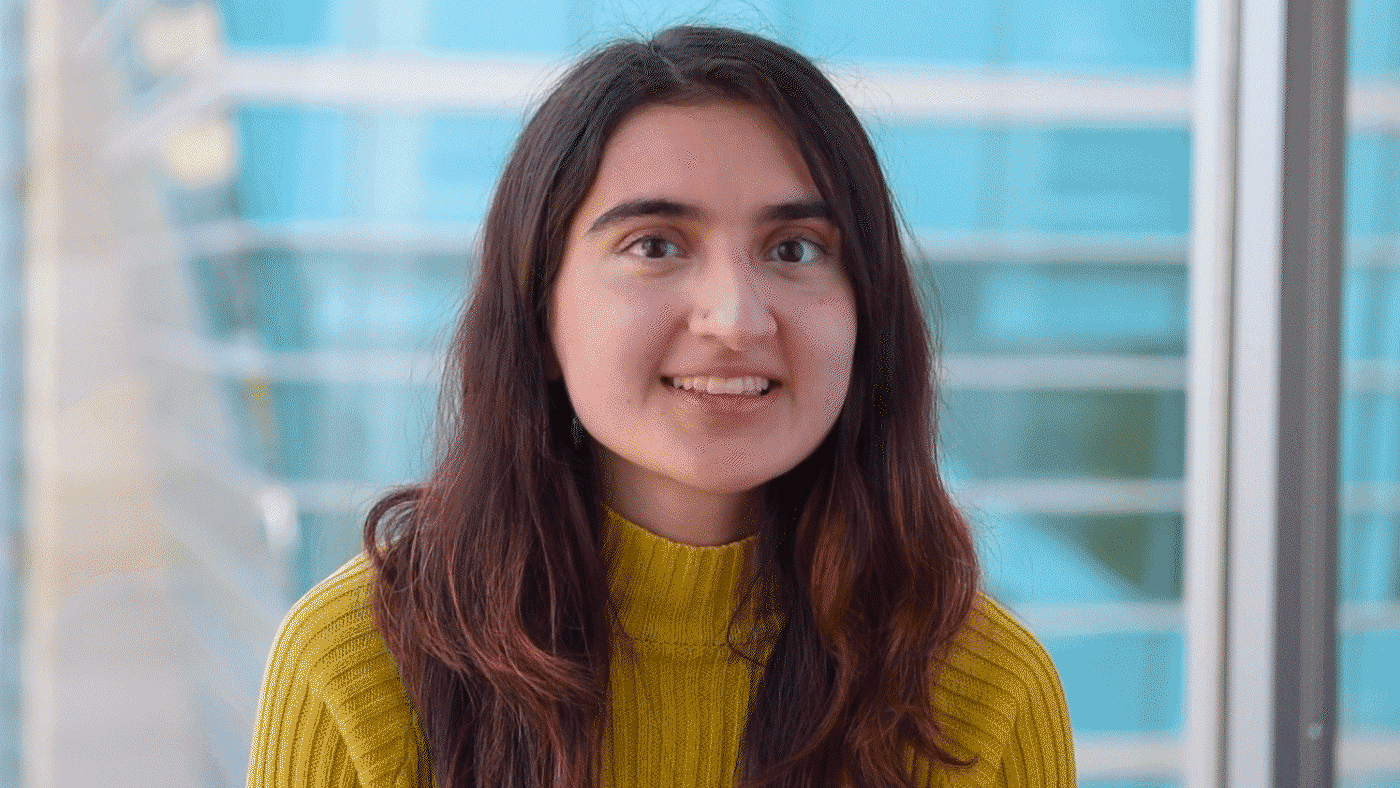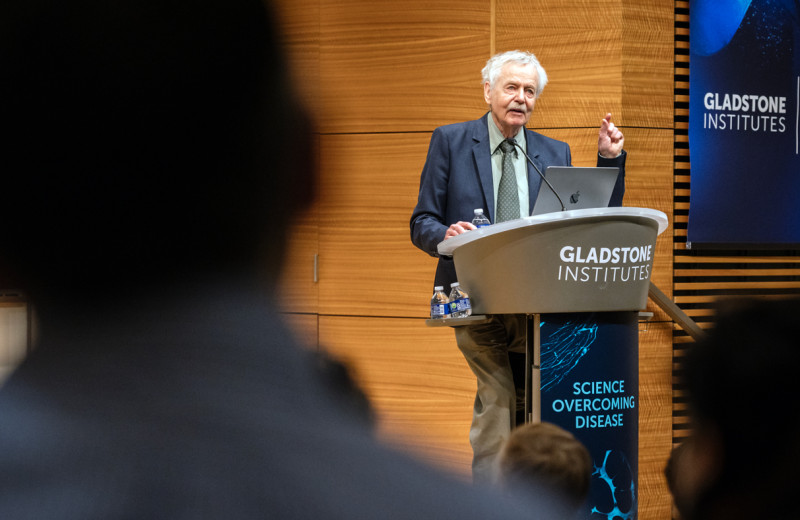Gladstone NOW: The Campaign Join Us on the Journey✕

Hailey Modi comes from a family of scientists and is passionate about cultivating the next generation of scientists.
Hailey Modi (she/her), a research associate in the laboratory of Ryan Corces, has been interested in science from a young age, particularly the science behind diseases. She majored in biomedical engineering at The University of Texas at Austin to learn more about the real-world applications of scientific and medical research.
During her undergraduate studies, Modi joined the laboratory of Aaron Baker and studied nerve damage after traumatic injury. There, she helped engineer and test neural microelectrodes, and published an undergraduate thesis on drug delivery methods that could speed up nerve regrowth.
Now, in the Corces Lab, Modi works on neurodegeneration in a different context as it relates to the epigenetics of neurodegenerative diseases, like Alzheimer’s and Parkinson’s. Her research experience has ignited a fascination with the brain, and she aims to join a neuroscience PhD program in the future.
What brought you to Gladstone?
I wanted to gain further neuroscience experience after graduating college, and I wanted to move to the San Francisco Bay Area to be closer to my parents. I came across the Corces Lab during my job search, and I was drawn to the complex epigenetic problems being studied here.
What do you like about working at Gladstone?
The support I’ve received here is unmatched. The actual facilities are state-of-the-art, which has allowed me to learn and develop new technical skills. On top of that, the culture is so welcoming. There’s so much collaboration between labs, and the administrative teams provide all kinds of resources to make our lives better. I’ll never forget getting extra days off for Thanksgiving and winter breaks in 2020—it meant so much during such a rough year, and I would have never expected any organization to do that!
Were you interested in science as a child?
Yes—my mother is a researcher who works on neuromuscular diseases, so she always encouraged me to pursue science. Visiting the hospital where she worked and seeing how her research improved patients’ lives really solidified my interest in human health and disease.
Can you describe your current research project?
I’m working on a new single-cell technique for the lab. Single-cell analysis involves separating individual cells from tissue samples, in our case brain tissue, and labeling each individual cell with a different “barcode.” Then, when we sequence the genetic information from all the cells in a piece of tissue, we can use the barcodes to find patterns in gene expression to classify the cells into subgroups and view similarities and differences between them.
Single-cell analysis of neurons is especially tricky; their unusual shape means that we can usually only isolate the nucleus of each cell. This means we lose all the genetic information in the form of RNA that’s floating around the cell and being translated into proteins.
There’s a new method called RAISIN-seq that can solve this problem, and I’ve been trying to use it on brain tissue. This method requires chopping the tissue into pieces by hand, and this gentler form of tissue breakdown retains the endoplasmic reticulum, as well as the nucleus.
This endoplasmic reticulum contains ribosomes that actively translate RNA into protein, and if it stays attached to the nucleus, then our single-cell experiments will give us a clearer picture of what genes are being expressed and affecting cell function. However, hand chopping the tissue wasn’t practical with the hundreds of brain samples we normally process in our lab. So I built and programmed robots to do the chopping for me! I’m now testing whether this protocol works in mouse models of brain inflammation. If it works, we’ll learn more about the genetic response that causes inflammation across the whole cell, instead of just in the nucleus.
What or who influenced your decision to work in science?
I mentioned my mother earlier; she was one of my biggest inspirations to do science. Both my parents and some of my extended family are in STEM fields, so I got a lot of support from them when I was younger.
I also had some amazing science teachers in middle school that made research and experimentation seem exciting.
What do you do when you are not working?
Lots of things! Since moving from Texas to the Bay Area, I’ve gotten a lot more outdoorsy—I like going to parks in the city to hike and bike, as well as running in my neighborhood. I’ve also started rock climbing and skiing. I’ve recently started taking voice lessons and practicing piano, two hobbies I had when I was younger that I’m trying to get back into. Finally, I’ve always been into video games, so I make time for playing those when I can.
If you could learn to do anything, what would it be?
I’d like to learn to surf! I plan to drive down to Pacifica or Santa Cruz to try it out when the weather gets warmer.
What is your hidden talent?
I’m excellent at memorizing lyrics and recognizing songs from just the tune.
If you could meet any scientist from any point in time, who would it be and why?
Rosalind Franklin. I’d want to tell her how, even though she didn’t win the Nobel Prize she deserved, people now recognize her more and more as the actual discoverer of DNA structure.
What kind of diversity, equity, and inclusion (DEI) work are you involved in?
I’ve been involved in outreach both inside and outside of the lab. Last year, all of us in the Corces Lab created a diversity statement for our lab website, and I designed a graphic to go with it. We’re also starting to present DEI papers at our journal clubs in addition to neuroscience ones. I plan on leading the first discussion (on gender bias in neuroimaging studies) in April.
In terms of other outreach, I volunteer with 826 Valencia where I tutor local K–12 students after school and help develop their writing skills. I also participate in Letters to a Pre-Scientist, a nationwide program that pairs scientists with a student pen pal to get them interested in pursuing STEM. I love working with kids, and inspiring the next generation is important to me.
March is Women’s History Month. What advice would you give to young women starting their scientific careers?
Perseverance is crucial. Science can be frustrating, and it can sometimes seem like you’re not getting anywhere. But the effort you put in will always result in something. Maybe it’ll take time to pay off, or maybe your work will inspire someone else to go further. But it always matters, even if you can’t see it right away.
Want to Join the Team?
Our people are our most important asset. We offer a wide array of career opportunities both in our administrative offices and in our labs.
Explore CareersA Sculptor of Modern Regenerative Medicine
A Sculptor of Modern Regenerative Medicine
Among his myriad accomplishments, Rudolf Jaenisch—winner of the 2025 Ogawa-Yamanaka Stem Cell Prize—was the first to demonstrate the potential of induced pluripotent stem cells to treat disease.
Awards Ogawa Stem Cell Prize Profile Regenerative Medicine Stem Cells/iPSCsMeet Gladstone: Shijie Wang
Meet Gladstone: Shijie Wang
Shijie Wang, a postdoctoral scholar in Steve Finkbeiner’s lab, uses artificial intelligence, robotics, and stem cell technologies to uncover how brain cells die in neurodegenerative diseases like Alzheimer’s and Parkinson’s.
Profile Neurological Disease Finkbeiner Lab AI Robotic MicroscopyMeet Gladstone: Oscar Yip
Meet Gladstone: Oscar Yip
Oscar Yip is advancing Alzheimer’s research in Yadong Huang’s lab at Gladstone while drawing inspiration from his family, community, and his broader goal of helping patients.
Graduate Students and Postdocs Profile Alzheimer’s Disease



